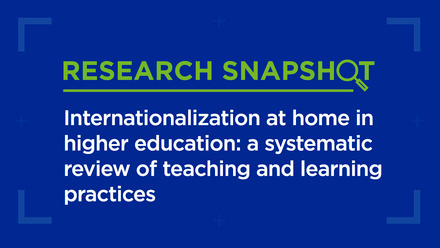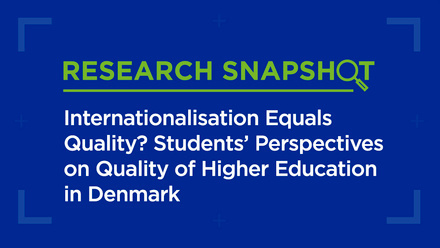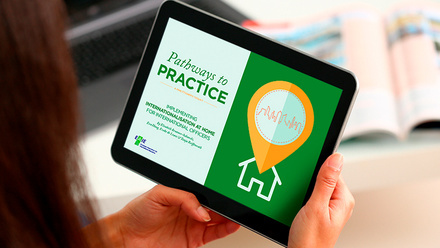Internationalisation at Home and institutional strategy

What does Internationalisation at Home (IaH) mean in practice? In its ongoing effort to prepare all students for a global society, the Romanian-American University has shifted from focusing purely on offering international opportunities within the home curriculum to looking more at learning outcomes that prepare all students for a life and career in the globalised environment.
Providing excellent opportunities for mobility and international activities abroad is an important start towards internationalising our institutions. But in addition to providing opportunities to the small proportion of students who are able to study abroad, institutions must strive to offer all students the skills and competencies they need to succeed in the global environment by incorporating internationalisation across the curriculum.
This is precisely the goal of Internationalisation at Home. As the Romanian-American University has undertaken internationalisation, it has considered two different definitions of IaH:
1. “Any international related activity with the exception of outbound student and staff mobility,” as defined in the EAIE position paper (2000)
2. “…the purposeful integration of international and intercultural dimensions into the formal and informal curriculum for all students within domestic learning environments,” as defined by Jos Beelen & Elspeth Jones (2015)
The first definition refers only to the type of international activities universities might engage in, whilst the second shows us the qualitative part, or the outcomes of our activities, resulting in students well-prepared for global competition.
IaH from activities to results
At the Romanian-American University, some years ago, we focused on the first definition, thinking that Internationalisation at Home means:
- Organising an international summer school for 20 students
- Inviting foreign professors for one week for a class of 40 students
- Launching study programmes taught in English
- Additional courses offered in English
- Extracurricular language courses, mainly for Asian languages
- Organising international conferences
- Training programmes (in-house) for a limited number of teachers
These examples indeed make important contributions to IaH. But we came to fully understand that IaH means international dimensions available for all students, not only those able to take part in these various activities. This led us more towards the second definition above.
We asked ourselves, what do we want to achieve? Being able to count a certain number of activities (like those noted here) or seeing tangible results both in the short and medium term for the benefit of all our students? To be clear, in order to develop comprehensive internationalisation, we realised that we do need such activities (and many of them). But in themselves they are not enough; an institution-wide impact can only be achieved with a focus on learning outcomes for all students.
At the same time, I realised the following. Even before hearing about the concept of IaH we were active in a range of curriculum initiatives:
- Launching/adapting curriculum (for Romanian taught programmes) with support from our partner universities in the US or Europe, in order to have compatibility on the one hand, and looking to benefit from their experience on the other hand;
- Adapting the syllabus, based on the cooperation of RAU professors with peers from abroad;
- Incorporating competencies (for our Romanian taught programmes) that are required by globalisation.
But we were not fully aware that such outcome-oriented undertakings are examples of IaH, and that by those means we can begin to cover all study programmes.
Some practical examples
In order to switch the focus onto all RAU students (including the 90% of students who do not benefit from international mobility) and also all staff, we implemented several projects and initiatives, including the following:
- Combining internationalisation with university-business cooperation (suggestions from businesses regarding student skills requirements that are strongly related to skills for globalisation);
- Offering more elective tracks in English and more credit courses offered by guest professors, currently reaching almost 40% of the student body;
- Requiring English for all students, both English as a foreign language and courses in English embedded in the mandatory curriculum for Romanian taught programmes;
- Introducing ‘soft skills’ into the mandatory curriculum for all study programmes (strongly required by the business environment);
- Curriculum (re)design of Romanian taught programmes. We benefited from the (re)accreditation cycle to incorporate internationalisation (I personally see English as crucial for a globally-prepared graduate. However, international dimensions are also delivered in the local language);
- Launching new study programmes with advice from business representatives and academics specialised in internationalisation;
- Offering English for all staff, a goal we are still working towards. A multiannual project to improve English skills, including for beginners, with internationally-recognised certification;
- Encouraging more staff to benefit from mobility programmes and increasing the impact of mobility. Beyond mobility numbers, proving the wider impact of international mobility is exactly what the funding units and national agencies are looking for. Although not part of the definition of IaH, we believe staff experiences based on international mobility can contribute to Internationalisation at Home.
At the Romanian-American University we have become aware of the fact that internationalisation should be implemented in an integrated manner, to create synergies for reaching the overall strategic goals. All activities should support and benefit each other. Thus, Internationalisation at Home has proved to be an essential component of RAU’s comprehensive internationalisation, delivering the best result that universities are actually seeking: students well prepared for global society and the labour market.
However, we still have work to do in reaching all students and staff. We need to better motivate students. We need to have more training related to internationalisation to include all staff, and to offer it in Romanian. We need to have more impact from mobility programmes and to learn from our experiences. We also need to focus on disciplines that are mainly connected with the local/national market (types of employers, procedures, habits, traditions). As Romania itself becomes more internationalised, even graduates from those fields will need skills for a global society.






